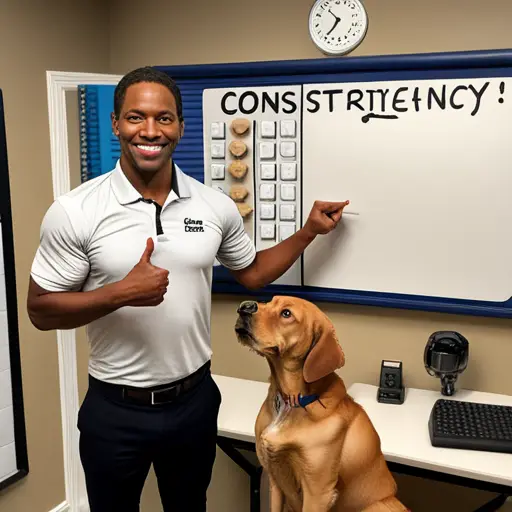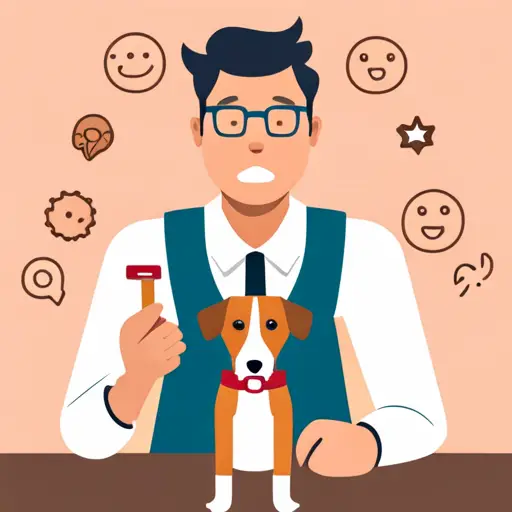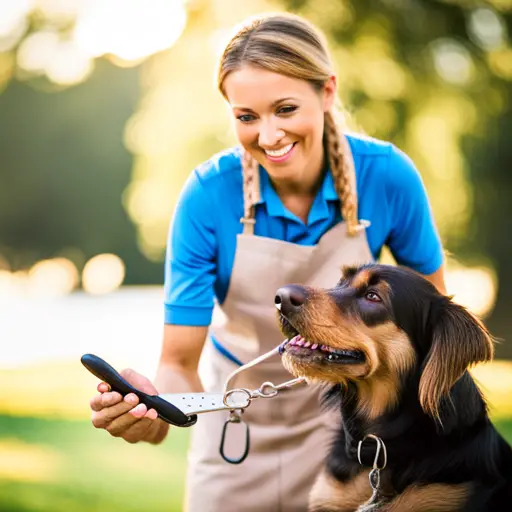Are you tired of your dog’s misbehavior and destructive habits? Do you wish your furry friend would listen to you and follow your commands? If so, then you’re in the right place.
Training your dog for good behavior is not just about obedience, it’s about building a strong bond between you and your pet.
In this article, you’ll learn tips and techniques for training any dog, regardless of breed or age. You’ll discover the importance of understanding your dog’s behavior and how positive reinforcement training can make all the difference.
We’ll also discuss the significance of consistency and persistence when it comes to training your dog and addressing specific behavioral issues.
By the end of this article, you’ll be equipped with the knowledge and tools necessary to help your furry companion become a well-behaved and obedient member of your family.
Key Takeaways
– Positive reinforcement training using treats and toys is effective in building a strong bond between owner and pet.
– Consistency and persistence in establishing routines and boundaries are crucial in training dogs.
– Understanding dog communication through posture, facial expressions, and vocalizations can help in identifying their emotions and behavior.
– Seeking professional help from certified dog trainers or behaviorists can provide customized plans and recommendations for a dog’s behavior.
Understanding Your Dog’s Behavior

If you want to train your furry friend, it’s crucial to understand your dog’s behavior. This means learning to read their body language and communication signals.
Dogs communicate with us in several ways, including through their posture, facial expressions, and vocalizations. For example, a wagging tail can indicate excitement or happiness, but a tucked tail can indicate fear or anxiety. Similarly, a relaxed body posture and open mouth can indicate a calm and friendly demeanor, while a stiff body and bared teeth can indicate aggression.
By becoming more attuned to your dog’s body language and communication signals, you can better understand their needs and wants. This will help you to communicate more effectively with them and to respond appropriately to their behavior.
In turn, this will make training your dog more effective and enjoyable for both you and your furry friend. Now that you have a better understanding of your dog’s behavior, it’s time to move on to positive reinforcement training.
Positive Reinforcement Training

If you’re looking for effective ways to train your furry friend, positive reinforcement training is the way to go. This technique involves rewarding your dog for good behavior, which helps them associate positive experiences with certain actions.
Clicker training is a popular form of positive reinforcement training that involves using a clicker to signal to your dog that they’ve done something right. Using treats and toys can also be a great way to motivate and reward your dog during training sessions.
Reward-Based Training Techniques
Reward-based training is one of the most effective techniques for teaching good behavior to any dog. This training technique focuses on rewarding the dog for good behavior instead of punishing them for bad behavior. Training without punishment helps build a strong bond between the dog and their owner, as the dog learns to trust and respect their owner rather than fear them.
When using reward-based training, it’s important to remember that the reward should be something the dog finds valuable, such as treats, toys, or praise. By rewarding good behavior, the dog learns what is expected of them and is more likely to repeat that behavior in the future.
Additionally, this technique can be used to reinforce positive behaviors that the dog is already exhibiting, which helps to strengthen the bond between the dog and their owner.
As you continue to train your dog using reward-based techniques, you may want to consider incorporating clicker training into your routine. This technique involves using a clicker to mark the desired behavior, followed by a reward. By using a consistent sound to mark the behavior, the dog learns to associate that sound with the reward, making it easier to train them in the future.
With consistent training and positive reinforcement, your dog can learn good behavior and become a well-behaved member of your family.
Clicker Training
Using a clicker during your dog’s training sessions can be a game-changer. The timing and precision of the clicker can help your dog quickly learn new commands and behaviors, making it easier for you to communicate with them.
Clicker training involves using a small device that makes a distinct clicking sound to mark a behavior that you want your dog to repeat. Once your dog hears the click, they know they’ve done something right and are likely to repeat the behavior. It’s a simple yet effective way to teach your dog new skills and reinforce good behavior.
But clicker training isn’t just about basic commands like ‘sit’ and ‘stay.’ It can also be used to shape complex behaviors. By breaking down these complex behaviors into smaller, more manageable parts, you can guide your dog towards the desired outcome.
For example, you can use the clicker to teach your dog to retrieve specific objects, jump through hoops, or even turn lights on and off. Clicker training is a powerful tool that can help you build a stronger relationship with your dog. And when combined with other positive reinforcement techniques, such as using treats and toys, you can create a training program that is both effective and rewarding for both you and your furry friend.
Using Treats and Toys
You can make training sessions more fun and engaging for your pup by incorporating their favorite treats and toys. Using treats as rewards for good behavior is a common practice, but it’s also important to choose the right toy to keep your dog motivated during training.
Here are some tips for selecting the best toys and treats for training motivation:
– Toy selection: Choose toys that are easy to handle and won’t distract your dog from the task at hand. Avoid toys that are too similar to items your dog may chew on or destroy, so they don’t get the wrong idea.
– Treat selection: Use high-value treats that your dog doesn’t get on a regular basis. Cut treats into smaller pieces to make them last longer and avoid overfeeding.
Remember, consistency and persistence are key to successful training. With the right motivation and tools, you can help your pup learn good behavior and enjoy the process along the way.
Consistency and Persistence

Maintaining consistency and persistence throughout your dog’s training is crucial for long-term success and behavior improvement. Establishing routines and setting clear boundaries from the very beginning will help your dog understand what’s expected of them.
Dogs thrive on routine and structure, and when they know what to expect, they’re more likely to behave appropriately. It’s important to remember that training your dog isn’t a one-time event. It requires ongoing effort and consistency to reinforce good behavior and discourage bad behavior.
This means that you need to be persistent even when it’s difficult or inconvenient. By consistently reinforcing good behavior and addressing any issues as they arise, you’ll be able to create a happy and well-behaved dog who’s a joy to be around.
In the next section, we’ll discuss how to address specific behavioral issues that may arise during your dog’s training.
Addressing Specific Behavioral Issues

When dealing with specific behavioral issues, it can be helpful to observe your pup’s body language and vocalizations to better understand their emotions and reactions. This will allow you to identify triggers that may be causing unwanted behavior, such as managing separation anxiety or dealing with aggression issues.
Once you have identified these triggers, you can work to modify your pup’s behavior through the following techniques:
1. Desensitization: This involves gradually exposing your pup to the trigger in a controlled environment, slowly increasing the intensity of the stimulus over time. This can be effective in reducing fear and anxiety related behaviors.
2. Counter-conditioning: This involves pairing the trigger with a positive experience, such as treats or playtime, to create a positive association in your pup’s mind. This can be effective in reducing reactive or aggressive behaviors.
3. Positive reinforcement training: This involves rewarding desired behaviors with treats, praise, or playtime to reinforce good behavior and encourage your pup to repeat it in the future.
By utilizing these techniques, you can address specific behavioral issues and improve your pup’s overall behavior. However, if you find that these techniques aren’t effective or the behavior is severe, it may be necessary to seek professional help from a certified dog trainer or behaviorist.
Seeking Professional Help

If your pup’s behavior is severe or not improving with at-home methods, it’s important to consider seeking professional help from a certified dog trainer or behaviorist. These experts have the knowledge and experience to assess your dog’s behavior, identify the root cause of the problem, and develop a customized training plan that suits your pup’s needs.
They can also provide you with practical tips and techniques to help you reinforce good behavior and reduce bad habits.
Finding experts who specialize in dog training is easy. You can ask for recommendations from your veterinarian, local pet stores, or dog owners in your community. You can also search online for certified dog trainers or behaviorists in your area.
While the cost of professional training may vary depending on the trainer’s experience and qualifications, it’s important to remember that investing in your dog’s behavior is an investment in your pup’s well-being and your relationship with them. With the help of a professional trainer, you can create a happier and healthier environment for your furry friend.
Conclusion
So now you know the basics of training your dog and addressing any behavioral issues that may arise. Remember to always use positive reinforcement, be consistent and persistent, and seek professional help if needed.
But did you know that according to a survey by the American Pet Products Association, 70% of dog owners believe that their pets understand the meaning of words and phrases? This just goes to show how intelligent and receptive our furry friends can be.
With the right training and techniques, your dog can learn to understand and respond to your commands, leading to a happier and more well-behaved companion. So don’t hesitate to invest time and effort into training your dog – it’ll pay off in the long run.
